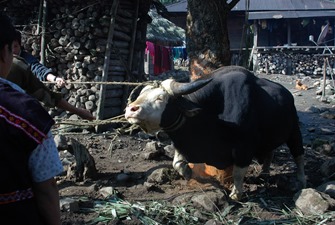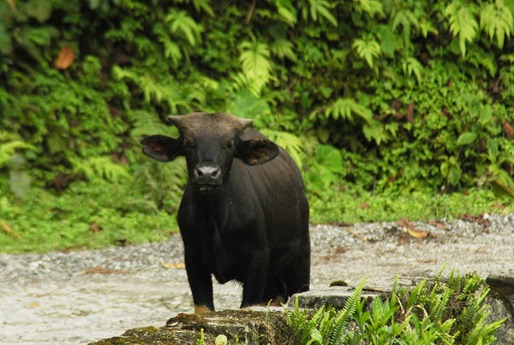This article, co-written by Karthik and myself appeared in the June issue of Eye magazine brought out by the Indian Express. Among the many things that both of us have written about, this was one of the closest to our hearts. When one stays in a remote village for a large part of the year, one cannot but feel a deep sense of kinship for the fellow inhabitants. They cease to be study subjects and assume the role of friends and family. The least we could have done for them was to present their struggles and difficulties to the rest of the country. We hoped against hope that somewhere in some swanky office room, some IAS or politician would chance upon this article and decide to do something about it. Well, it doesn’t hurt to hope, does it?
Click here for the pdf copies of the article. Or just read on below:
THE TWO-month-old mithun calf lay by the side of the road. Its lifeless glassy eyes stared into nothingness, but its feet twitched occasionally in spasms before death finally came. The young mother stood unsurely beside the calf, licking it at intervals. Scenes like this played out virtually every day in the last few months, reminding us of the epidemic that had besieged this remote corner of Arunachal Pradesh. The killer was a virus (Aphthae epizooticae) belonging to the Picornaviridae family, causing the dreaded Foot-and-mouth disease.
Bomdo village in the Upper Siang district of Arunachal Pradesh is peopled by the Adi tribe, the second most numerous tribe in the state. Further towards the north lies Tuting, the last town before the border with Tibet. The mighty Siang River flows below the village, while the snowcapped mountains to the north provide a glimpse of the spectacular beauty of the Siang valley. It's a picturesque agrarian society, except all is not well.
Foot-and-mouth disease (FMD) had made its way into the mountains from the plains of Pasighat. The worst affected were the semidomesticated mithun (Bos frontalis) that were dying out even as their owners watched helplessly. Each day, as one more animal was found dead in the forest or beside the road, another few were seen salivating profusely from the mouth as the infection spread rapidly.
To a person unfamiliar with this region and the lifestyle of the people, it would seem to be just a minor problem. Surely, livestock die all the time across the country. So what was so different about these deaths?
It is impossible to gauge the scale of the tragedy without an understanding of what mithuns mean to people in these parts. The mithun is an integral part of the cultural and socio-economic life of a majority of the tribes of Arunachal Pradesh. Among the Adis, the number of mithuns owned by a man determines his wealth and prestige. Traditionally, it has been used for barter, paying fines as well as bride price. Even today, mithuns are used as a form of currency in villages across the state. The Adis are primarily animists and major festivals such as Solung, Mopun and Aran are inconceivable without the animal’s sacrifice. When a member of the Adi community dies, he is buried with the skulls of the mithun that he had offered in sacrifice during his lifetime.
An adult mithun weighs about 500 kg and its meat forms one of the most important sources of protein for remote tribal villages like Bomdo, which do not have access to town markets. Incredibly, this animal demands minimal care from their owners. Mithuns are free-ranging and reside in the forests around the village. The only attention they demand are occasional treats of salt that are provided by their owners. The price of an adult mithun in the Upper Siang ranges from Rs 25,000-30,000.
FMD is a highly infectious viral disease that affects both domestic (cattle, pigs, sheep and goats) and wild (buffalo, gaur, deer, wild pigs and many more) even-toed ungulates. Since its first description in 1546 and the discovery of the virus in 1897 by Loeffler and Flosch, it is considered to be one of the greatest threats to animals. The disease gets its name from the advanced pathological symptoms which manifest as lesions in the foot and mouth and excessive drooling of saliva. It spreads through contact. About 5,000 outbreaks of the disease have been recorded from India that have affected about three lakh animals resulting in an economic loss of about Rs 4,300 crore annually. While these figures are startling, it is derived mostly from livestock deaths in mainland India, while much of the mithun and livestock deaths in the hills remain unreported. Sadly, even the most accurate figures would not reflect the cultural and socioeconomic losses that hill communities such as the Adis are facing.
There is also the very real risk of the disease spreading to other wild animals. This area is located very close to the Mouling National Park and the Dihang Dibang Biosphere Reserve. The community lands around the villages too harbour an incredible diversity of wildlife. As mithuns are free-ranging, they can very well spread the disease across the landscape.
The warning signs have been around for almost a year in the form of an outbreak among other districts in Arunachal Pradesh. Occurence of FMD was reported last year in September from Kurung Kumey district in western Arunachal Pradesh, following which it was reported from the east and west Siang districts in January this year. In the last two months, the disease has spread to the mithuns in Upper Siang district and caused the deaths of about 25 mithuns in Bomdo village alone. Several more deaths have occurred in other villages along the Pasighat-Tuting Border Road. These figures, however, are only of those animals which have been found. It is possible that the actual death toll is much higher as several animals could have already died within the forest and remained undiscovered.
This is not the first time that FMD has come to this part of the country or the state. An epidemic of FMD had also occurred earlier in 57 villages in the state between 1994 and 1995, infecting 6,237 mithuns and killing over 800 animals. Even the strain of FMD causing the earlier epidemic in Arunachal Pradesh was identified as the Asia1 virus serotype.
To their credit, the veterinary department is supplying free vaccines and medicines to the villagers. Unfortunately, the onus is on the villagers to come to the nearest town and collect the vaccines or the medicines. In remote areas, this is a major limiting factor as it involves a long unenviable walk in the absence of local transport or motorable roads. FMD can be prevented through vaccination of unaffected animals and enforcement of quarantine to stop carriers from mingling with other animals. Last year, the ‘Mithun Health Camp’ organised by the Krishi Vigyan Kendra in some parts of Papum Pare district, where medicines were distributed and mithuns vaccinated, raised awareness to a large extent. Similar programmes need to be implemented to stop future outbreaks.
It is a bit late to be able to do anything for the people of the Bomdo village and various other affected villages. There have been calls earlier to compensate mithun-owners for their losses, notably from senior politicians within the state. While this would certainly be of great help to people in these remote villages, eliminating FMD and eradicating such epidemics from the hills, would be the best possible compensation.




